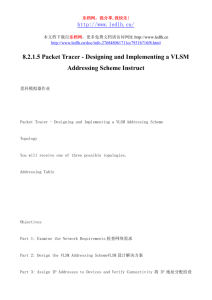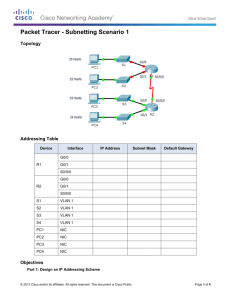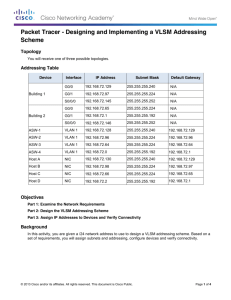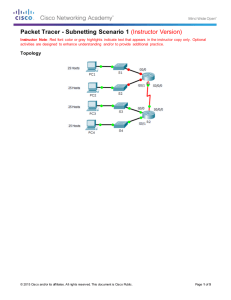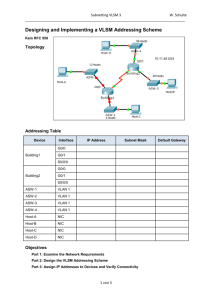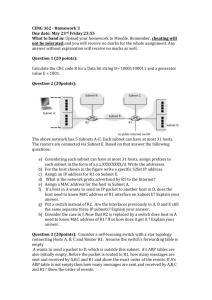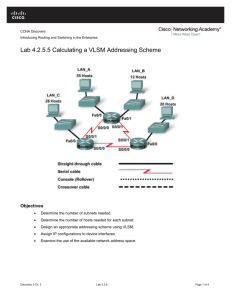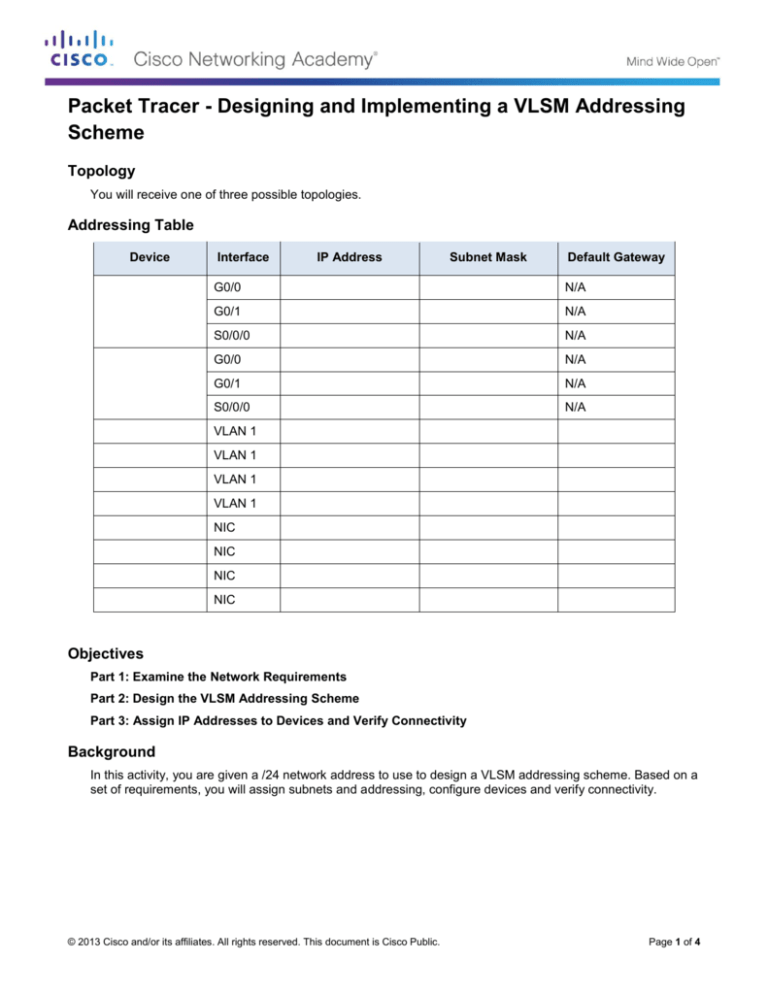
Packet Tracer - Designing and Implementing a VLSM Addressing
Scheme
Topology
You will receive one of three possible topologies.
Addressing Table
Device
Interface
IP Address
Subnet Mask
Default Gateway
G0/0
N/A
G0/1
N/A
S0/0/0
N/A
G0/0
N/A
G0/1
N/A
S0/0/0
N/A
VLAN 1
VLAN 1
VLAN 1
VLAN 1
NIC
NIC
NIC
NIC
Objectives
Part 1: Examine the Network Requirements
Part 2: Design the VLSM Addressing Scheme
Part 3: Assign IP Addresses to Devices and Verify Connectivity
Background
In this activity, you are given a /24 network address to use to design a VLSM addressing scheme. Based on a
set of requirements, you will assign subnets and addressing, configure devices and verify connectivity.
© 2013 Cisco and/or its affiliates. All rights reserved. This document is Cisco Public.
Page 1 of 4
Packet Tracer - Designing and Implementing a VLSM Addressing Scheme
Part 1: Examine the Network Requirements
Step 1: Determine the number of subnets needed.
You will subnet the network address
requirements:
. The network has the following
LAN will require
host IP addresses
LAN will require
host IP addresses
LAN will require
host IP addresses
LAN will require
host IP addresses
How many subnets are needed in the network topology?
Step 2: Determine the subnet mask information for each subnet.
a. Which subnet mask will accommodate the number of IP addresses required for
?
How many usable host addresses will this subnet support?
b. Which subnet mask will accommodate the number of IP addresses required for
?
How many usable host addresses will this subnet support?
c.
Which subnet mask will accommodate the number of IP addresses required for
?
How many usable host addresses will this subnet support?
d. Which subnet mask will accommodate the number of IP addresses required for
?
How many usable host addresses will this subnet support?
e. Which subnet mask will accommodate the number of IP addresses required for the connection between
and
?
Part 2: Design the VLSM Addressing Scheme
Step 1: Divide the
subnet.
. network based on the number of hosts per
a. Use the first subnet to accommodate the largest LAN.
b. Use the second subnet to accommodate the second largest LAN.
c.
Use the third subnet to accommodate the third largest LAN.
d. Use the fourth subnet to accommodate the fourth largest LAN.
e. Use the fifth subnet to accommodate the connection between
.
and
Step 2: Document the VLSM subnets.
Complete the Subnet Table, listing the subnet descriptions (e.g.
LAN), number of hosts
needed, then network address for the subnet, the first usable host address, and the broadcast address.
Repeat until all addresses are listed.
© 2013 Cisco and/or its affiliates. All rights reserved. This document is Cisco Public.
Page 2 of 4
Packet Tracer - Designing and Implementing a VLSM Addressing Scheme
Subnet Table
Subnet
Description
Number of
Hosts
Needed
Network
Address/CIDR
First Usable
Host Address
Broadcast
Address
Step 3: Document the addressing scheme.
a. Assign the first usable IP addresses to
for the two LAN links and the WAN link.
b. Assign the first usable IP addresses to
usable IP address for the WAN link.
for the two LANs links. Assign the last
c.
Assign the second usable IP addresses to the switches.
d. Assign the last usable IP addresses to the hosts.
Part 3: Assign IP Addresses to Devices and Verify Connectivity
Most of the IP addressing is already configured on this network. Implement the following steps to complete
the addressing configuration.
Step 1: Configure IP addressing on
LAN interfaces.
Step 2: Configure IP addressing on
, including the default gateway.
Step 3: Configure IP addressing on
, including the default gateway.
Step 4: Verify connectivity.
You can only verify connectivity from
,
, and
. However, you should be able to ping every IP address listed in the Addressing
Table.
© 2013 Cisco and/or its affiliates. All rights reserved. This document is Cisco Public.
Page 3 of 4
Packet Tracer - Designing and Implementing a VLSM Addressing Scheme
Suggested Scoring Rubric
Activity Section
Part 1: Examine the
Network Requirements
Question
Location
Possible
Points
Step 1
1
Step 2
4
Part 1 Total
Earned
Points
5
Part 2: Design the VLSM Addressing Scheme
Complete Subnet Table
25
Document Addressing
40
Part 2 Total
65
Packet Tracer Score
30
Total Score
100
ID:
© 2013 Cisco and/or its affiliates. All rights reserved. This document is Cisco Public.
Page 4 of 4

